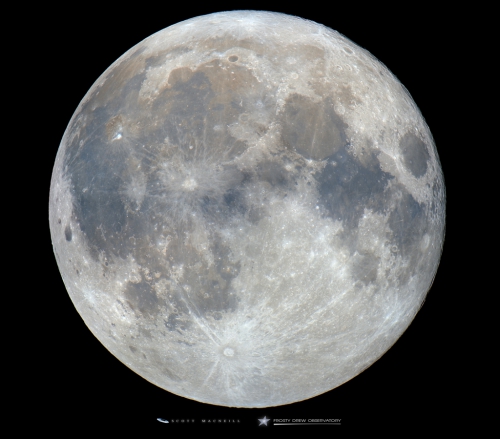
Stargazing Nights - CLOSED
- Where:
- Frosty Drew Observatory
- When:
- Friday March 2, 2018 - CLOSED
- Cost:
- $1 Suggested Donation per Person
Tonight is Stargazing Night at Frosty Drew Observatory and the ongoing Nor'easter is setup to crash our night of celestial amazement. Heavy rain, high winds, and flooding will keep Frosty Drew Observatory and Sky Theatre closed tonight. The bright 99% waning gibbous Moon, which is one day past full, would have hammered our view of the sky anyway. Though any chance to observe the sky in between the relentless bouts of intense rainfall and clouds, are coveted opportunities. We will return to our regular Stargazing Nights schedule on Friday, March 9, 2018.
----------------------
Weekly Happenings
Scott MacNeill
Last night at 7:51 p.m. EST (Thursday, March 1st) the full lunar phase occurred. Since it takes 29.5 days for lunar phases to complete one full cycle, the next full lunar phase will occur on Saturday, March 31st at 8:37 a.m. EDT. Based on modern definition, that makes the March 31st Full Moon a Blue Moon, and the second Blue Moon so far in 2018. January’s Blue Moon occurred on January 31st at 8:27 a.m. EST. Being that February had only 28 days this year (not a leap year), the short month got the shaft on the Full Moon. Following older definitions of the Blue Moon, which states that the third Full Moon in a season with four Full Moons, is the Blue Moon; neither the second January Full Moon or the second March Full Moon would have been considered Blue Moon’s. Embrace the current definition and the March 30-31st Full Moon will offer a second chance at catching site of the Blue Moon for those who missed it in January.
On Sunday, March 11, 2018 at 2:00 a.m., Daylight Savings Time will kick in, stealing an hour of stargazing or sleep, depending on your priorities. A good mnemonic for remembering which way to turn your clock: “In the fall, fall back one hour. At spring, spring forward one hour”. So don’t forget to spring your clocks forward one hour on Sunday morning, March 11th.
Over the next couple weeks, Mercury will be at best viewing in the western sky just after sunset. Mercury takes 88 Earth days to complete one full orbit around the Sun. This places Mercury in the morning sky just before sunrise twice per year, as well as in the evening sky just after sunset twice per year. Being closer to the Sun than Earth, we have to look towards the Sun to observe Mercury and only see it when it arrives on either side of the Sun. If you have clear skies over the next few nights, you can catch Mercury right next to Venus, low on the western horizon in dusk.
This past week, Jupiter, which is currently residing in the constellation Libra, has started to rise before midnight. With each passing night Jupiter will rise earlier, eventually rising around sunset on May 9, 2018, when opposition occurs. Jupiter is one of the more exciting planets we view at Frosty Drew Observatory in our telescope. Whether it’s the four Galilean Moons, the dark and dynamic equatorial bands in Jupiter’s atmosphere, the Great Red Spot, or any number of fabulous shadow transits compliments of it’s huge size, 3° axial tilt, and four large satellites with stable orbital resonance; Jupiter is a fabulous world to observe. In about mid-March we will begin viewing Jupiter regularly at Frosty Drew Observatory. Though if you are up before sunrise, you have probably been noticing Jupiter blazing brightly overhead in the southern sky for the past month. Jupiter is one of four planets lined up for stunning views this summer, alongside Venus, Mars, and Saturn. So don’t miss out on a fabulous view of the Solar System this summer at Frosty Drew Observatory!
-Scott


